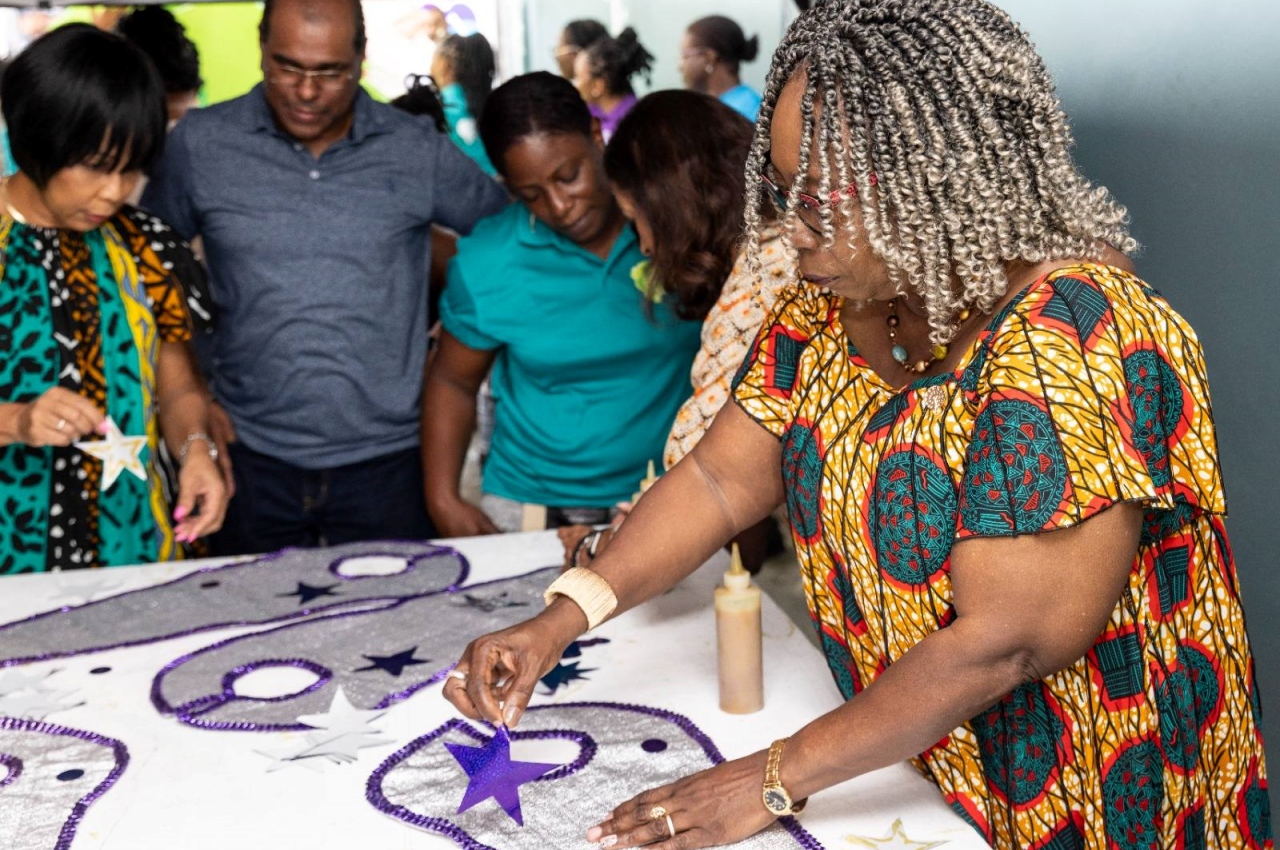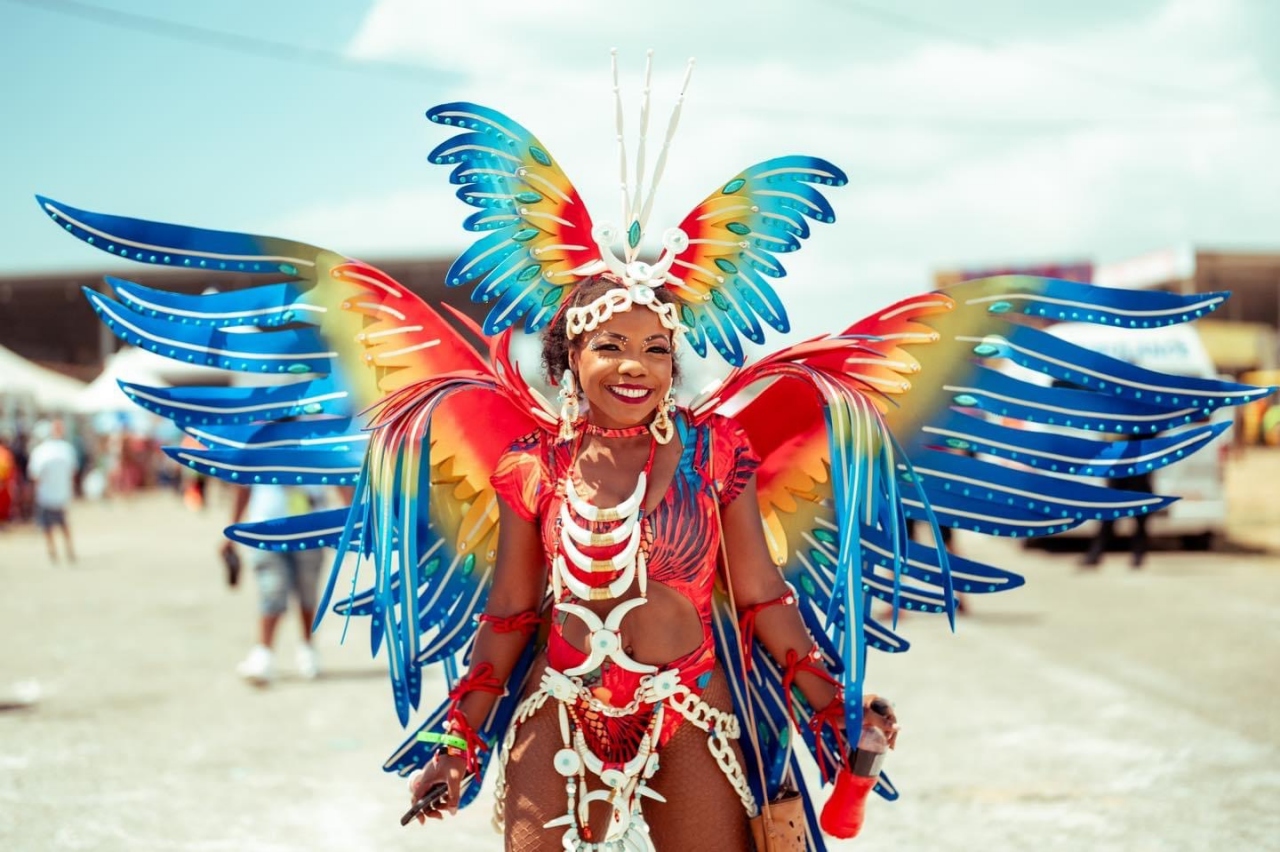ŌĆ£[ŌĆ”] Delicate pink or white lace accentuates the dress. Gossamer veils cascade from oversized hats or bonnets tied beneath the chin by a silky ribbon. Supple white gloves, a veil or mask, sheer stockings, and, on the feet, tightly laced Mary JanesŌĆöif you own a pair. A doll with rosebud lips and bright eyes finishes the costume.┬Ā
ŌĆ£The Baby Doll character comes to life…
ŌĆ£[ŌĆ”] Trinidadian author┬ĀJeff Henry explains┬Āthe origin of the character as a representation of ŌĆśthe sexual exploitation of women from the days of bondage when slave owners saw it as their right to demand sexual favours from their bond women. These women had no rights under the law and submitted to the sexual demands of their owners or estate overseersŌĆÖŌĆ”ŌĆØ

(Copyright Patrick Rasoanaivo)
The following is the first of a series of articles on ŌĆśthe essence of Trinidad and TobagoŌĆÖs CarnivalŌĆÖ by Avah Atherton titled ŌĆśThe Art of RebellionŌĆÖ:
Listen carefully. This is where it all began. Down through the hill towns, Belmont and Laventille, and through the streets of the capital, Port-of-Spain. In the Republic of Trinidad and Tobago, the southernmost islands in the Caribbean.┬Ā
Born out of the desperate attempts of enslaved Africans to protect what little they had left of their culture. Carnival.
A frenzy of beautiful bodies covered in varying amounts of beads and feathers. A riot of colour pulsating to the sounds of our local musical genres:┬Ācalypso┬Āand its contemporary incarnation,┬Āsoca.┬Ā
Old and young, locals and foreigners, masqueraders and spectators, all are captivated. This is Carnival Monday and Tuesday. This is what most of the world sees.

(Copyright Allan V Crane/Wired868)
But this is all a beautiful lie, a glorious mask that shields the true nature of Carnival. Welcome to the Art of Rebellion.
The┬ĀArt of Rebellion is a series of articles that reveals, through an exploration of important traditional Carnival characters, the essence of Trinidad and TobagoŌĆÖs Carnival, one of the most influential street festivals in the world.
*****
Beginning just after Christmas, the Carnival season is marked by weekly┬Āfetes┬Ā(parties), competitions, and, in every neighbourhood, the unmistakable sound of the steelpan.┬Ā
Carnival practitioners spend months preparing for the culmination of the festivities on the two days immediately preceding the Catholic observance of Ash Wednesday. With its long history, Carnival combines costuming elements of the European colonisers with religious and traditional aspects of African, Indian, and Indigenous cultures. While some characters and rituals originated during the Slave Trade, the end of slavery in 1838 ushered in the official two-day celebration.┬Ā

Moko Jumbies originated in African mythology. These are the ancestral spirits which crossed the Atlantic ocean to protect the Africans captured during the slave trade. (Copyright Maria Nunes)
In many ways, it served, then and now, as a form of healing, rebirth, and transformation for Trinidadians and Tobagonians.
Carnival in Trinidad has inspired offshoots in major cities around the world, but still thousands of visitors flock to the island state to experience events first-hand. This has made Carnival a significant economic driver for local artistes.┬Ā
However, traditional knowledge related to historical characters and rituals too often die with practitioners, robbing younger generations of their cultural inheritance. Although traditional characters remain commonplace in TrinidadŌĆÖs Carnival, their origins and importance have faded from the memories of most locals.
In their place, a mass-produced Carnival has emergedŌĆöone that tramples the efforts of our ancestors to be seen, heard, and understood using the social and political commentary that accompanies most traditional characters. As their cries fade, so too does our ability to truly understand our history and ourselves.┬Ā
Today, there are traditional masqueraders who choose to maintain the original portrayals, and others who subvert them in order to give them bold new meanings.

(via Torontoist.com)
Mas, the shortened form of masquerade, is divided into two main categories:┬Āpretty mas┬Āand┬Āole (old) mas.┬Ā
Pretty mas costumes, the more glamorous version of TrinidadŌĆÖs Carnival, feature stylised body suits or bikinis with matching arm and leg pieces along with a wire-frame shoulder or head piece.┬Ā
Ole mas consists of traditional Carnival characters such as Baby Doll, Moko Jumbie, Midnight Robber, Fancy Indian, Jab Jab, Burrokeet, and Bat.┬Ā
While pretty mas is more popular today, communities where traditional characters originated and those interested in cultural preservation maintain elements of the old costuming and performance.┬Ā
These characters are both products of and rebellions against the countryŌĆÖs history of colonisation, slavery, indentureship and displacement.

(Copyright Dwain Thomas)
*****
Delicate pink or white lace accentuates the dress. Gossamer veils cascade from oversized hats or bonnets tied beneath the chin by a silky ribbon. Supple white gloves, a veil or mask, sheer stockings, and, on the feet, tightly laced Mary JanesŌĆöif you own a pair. A doll with rosebud lips and bright eyes finishes the costume.┬Ā
The Baby Doll character comes to life.
They roam the streets during Carnival, accusing male spectators of being their childŌĆÖs father and demanding immediate child support. Often, the masquerader refuses to leave, becoming louder and more insistent until the alleged father responds with a few dollars.┬Ā
The chagrin of the accused is heightened by the amusement of the spectators, but the Baby Doll is not yet done, moving boldly to the next man and unashamedly making the same accusations and demands.

The character is used to give agency to the women who played the part, similar to contemporary portrayals in the Caribbean.
(Copyright Bradley Smith)
The Baby Doll character represents many layers of historical oppression and disenfranchisement. Trinidadian author┬ĀJeff Henry explains┬Āthe origin of the character as a representation of ŌĆśthe sexual exploitation of women from the days of bondage when slave owners saw it as their right to demand sexual favours from their bond women. These women had no rights under the law and submitted to the sexual demands of their owners or estate overseers.ŌĆÖ
During the Slave Trade, illegitimate children were considered merely another product of the plantation and were often sold off, tearing families apart while ensuring a constant supply of low-cost labour. An 1813 registry of enslaved Africans in Trinidad shows that, at that time, almost half of the enslaved population had European ancestry.
Few spectators, even locals, understand the Baby Doll within the political and social context of the late 19th century, when women were disenfranchised in many areas of life. Under British colonisation, from 1763 to 1962, class and race restrictions denied women of colour and their offspring basic rights and privileges.
Local writer Debbie Jacob positions the Baby Doll character as an ŌĆśextortionŌĆÖ masquerade, stating that masqueraders used the performance ŌĆśto confront the upper-class society that marginalised themŌĆÖ.
Still,┬Āthe character can easily be dismissed by spectators as a promiscuous, irresponsible woman.
Dancer and Carnival band leader┬ĀMakeda Thomas describes┬Āthe character in an interview for the┬ĀTrinidad Guardian┬Ānewspaper:┬ĀŌĆ£ItŌĆÖs about a mother who is trying to hold someone accountable for a child, and can be played very pitifully, and IŌĆÖve seen our reaction to that type of performance be very disdainful.ŌĆØ
Today, portrayals by local activists position the Baby Doll as a means of addressing prevalent problems in Caribbean society, advocating for feminist social justice, particularly in the areas of gender and sexuality.
ŌĆ£This is a performance by women, to check the men in the community for behaviours that are harming the community,ŌĆØ Thomas declares.┬Ā
In 2019, she and her band formed the Belmont Baby Dolls to change the narrative surrounding the Baby Doll masquerader. They used the character to affirm motherhood, female sexuality┬Ā and the lived experiences of Black women.

(Photo by Patrick Rasoanaivo)
ŌĆ£We can place the power of this mas in healing, in our love relationsŌĆ” versus the parody, the satire, the┬Ādrama,ŌĆØ Thomas says.┬Ā
In so doing, her group creates ŌĆśspace for something other than traumaŌĆÖ.
Their portrayals explore relationships to create a healing transformation that embodies the spirit of Carnival.┬Ā
ŌĆ£Which is what mas is about, right?ŌĆØ she asks. ŌĆ£That there is something that happens through the costuming, but also the performance of that thing and the intention, especially in our colonial context, in which we were bred to hate ourselves. And you know, hate comes quicker than love.ŌĆØ
Jacqueline Burgess is a 73-year-old mas veteran who has been participating in Carnival for over 60 years.┬Ā
ŌĆ£I played pretty mas, I also played traditional mas, I played Bat, Burrokeet, I played the Midnight Robber,ŌĆØ she says. ŌĆ£But I really loved the Baby Doll.ŌĆØ

She makes subtle changes to her individual portrayal of the Baby Doll masquerade each year to reflect social issues.
(Copyright Maria Nunes)
Burgess dismisses the traditional portrayal of the character, stating that masqueraders have moved beyond a performance that is demeaning to women and have chosen to use it as a form of protest art. When Burgess created a Baby Doll workshop and gave masqueraders design autonomy, they used their performance to highlight the issues of the day.
ŌĆ£Domestic violence was addressed, HIV/AIDS, policing and police brutality, even sexual and reproductive rights,ŌĆØ Burgess says.┬Ā
She believes the character can empower women, that women should craft their own narrative based on their experiences.
These issues are prevalent and worsening: in 2020, half of the reported murders of women in Trinidad and Tobago were as a result of domestic violence.┬Ā

Police arrested her former husband.
Earlier this year, two boys witnessed the death of their mother, Adeina Alleyne, at the hands of their father. Prior to the attack, Alleyne had made several reports of domestic abuse and violence to the police. To no avail.┬Ā
Large-scale unemployment due to the Covid-19 pandemic further exacerbated these problems, as domestic abuse reports for the first few months of 2021 nearly doubled compared to the same period last year.
As the organiser of a childrenŌĆÖs band and network coordinator for the Advancement of Women and Working Women for Social Progress, Burgess promotes the Baby Doll as an advocacy tool for year-round exploration of societal issues and to build a community of support for women.┬Ā
In 2011, she created a Baby Doll band to commemorate the 100th International WomenŌĆÖs Day.
ŌĆ£It is such a powerful character that you can use it for almost anything,ŌĆØ she says. ŌĆ£That whole thing about advocacy and how you build and share awareness of certain issues, the Baby DollŌĆÖs voice could be used.ŌĆØ

However, Amanda McIntyre, sporting a black Baby Doll costume, joined a group of people who marched around the QueenŌĆÖs Park Savannah on the scheduled Carnival days.
(Copyright Lisa Fernandez)
EditorŌĆÖs Note: This article originally appeared in Smithsonian Folklife Magazine. Wired868 will publish the second and final part of the Baby Doll Masquerade on Monday 8 November.
Avah Atherton is an aspiring cultural archivist with a focus on oral histories, folklore, and festival traditions. Her work has been published locally in the Trinidad Express, UWI Today, and Wired868, as well as internationally in the Shizuoka Chronicle, AJET blog, Connect magazine, and Smithsonian Center for Folklife and Cultural Heritage.
She has an AAS in Journalism and Public Relations from COSTAATT as well as a BA in Linguistics and a PgDp in Arts & Cultural Enterprise Management from the University of the West Indies, St Augustine campus.
 Wired868 Wired868 for smart sport news and opinion
Wired868 Wired868 for smart sport news and opinion






